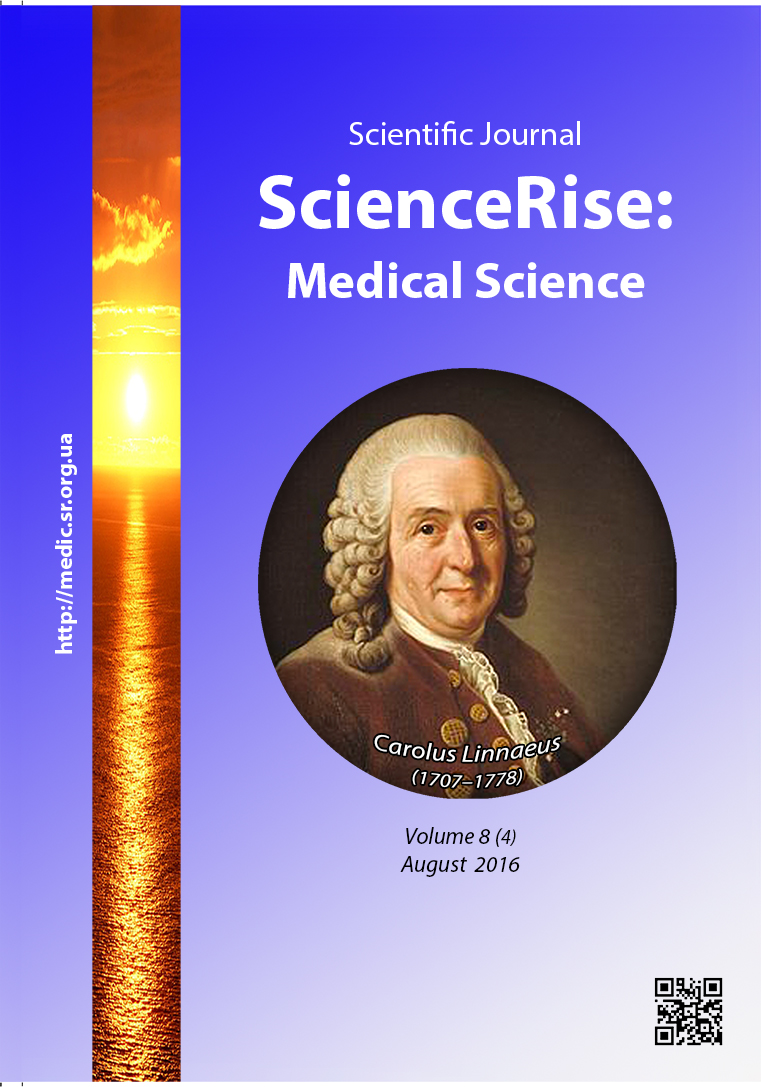Характеристика взаємозв’язку післяінсультної спастичності із клінічними та параклінічними факторами
DOI:
https://doi.org/10.15587/2519-4798.2016.76555Ключові слова:
післяінсультна спастичність, кореляційні взаємозв’язки, патогенетичні підтипи інсульту, збуджуючі та гальмівні нейромедіаториАнотація
Досліджено кореляційні взаємозв’язки післяінсультної спастичності з деякими клінічними та параклінічними факторами. Виявлена достовірна позитивна кореляція спастичності із ступенем важкості інсульту, курінням в анамнезі, локалізацією інсульту у каротидному басейні та рівнем глутамату й аспарату у найгострішому періоді. Також виявлено негативну середньої сили кореляцію ступеня вираженості спастичності та вмістом гліцину й таурину в найгострішому періоді ішемічного інсульту
Посилання
- Golovchenko, U. I., Treshchinskaya, M. A. (2009). Prophylaktika insylta. Kyiv, 36.
- Murashko, N. K., Afanasev, V. V., Rumyanceva, C. Y., Sulik, R. V. (2013). Gostri porushennya mozkovogo krovoobigu: diagnostuka i likuvannya. Kyiv, 35.
- Nikolaev, S. G. (2013). Elektromiographyya: klinicheskiy praktikum. Ivanovo: PresSto, 393.
- Mishchenko, T. S., Shestopalova, L. F., Trishunka, M. A. (2008). Klinichni shkalu i psychodiagnostuchni testu y diagnostuzi sydunnuch zahvoryvan holovnogo mozky. Kharkiv, 36.
- Wissel, J., Manack, A., Brainin, M. (2013). Toward an epidemiology of poststroke spasticity. Neurology, 80 (3), S13–S19. doi: 10.1212/wnl.0b013e3182762448
- Tkachenko, O. V., Zoha, I. O. (2010). Ishemichnuy insult. Musteztvo likuvatu, 6 (72), 52–58.
- Flomin, U. V., Gulaeva, M. V., Samosuk, N. I. et. al. (2014). Lechenie insulta v stazionare: kluchevue factoru, opredelyaushchie ishodu bolezni. Mizhnarodnuj nevrologichnuj jurnal, 7 (69), 46–57.
- Mehrholz, J., Major, Y., Meißner, D., Sandi-Gahun, S., Koch, R., Pohl, M. (2005). The influence of contractures and variation in measurement stretching velocity on the reliability of the Modified Ashworth Scale in patients with severe brain injury. Clinical Rehabilitation, 19 (1), 63–72. doi: 10.1191/0269215505cr824oa
- Lundström, E., Smits, A., Terént, A., Borg, J. (2010). Time-course and determinants of spasticity during the first six months following first-ever stroke. Journal of Rehabilitation Medicine, 42 (4), 296–301. doi: 10.2340/16501977-0509
- Faist, M., Mazeret, D., Dietz, В., Pierrot-Deseilligy, E. (2010). Tension development and muscle activation in the leg during gait in spastic hemiparesis; independence of muscle hypertonia and exaggerated stretch reflexes. Brain, 117, 1449–1455.
- Nguyen, T. T. H., Bhattarai, J. P., Park, S. J. Han, S. K. (2013). Activation of Glycine and Extrasynaptic GABAAReceptors by Taurine on the Substantia Gelatinosa Neurons of the Trigeminal Subnucleus Caudalis. Neural Plasticity, 2013, 1–12. doi: 10.1155/2013/740581
- Foran, J. R., Steinman, S., Barash, I., Chambers, H. G., Lieber, R. L. (2005). Structural and mechanical alterations in spastic skeletal muscle. Developmental Medicine & Child Neurology, 47 (10), 713–717. doi: 10.1111/j.1469-8749.2005.tb01063.x
- Lance, J. W.; Feldman, R. G., Young, R. R., Koella, W. P. (Eds.) (1980). Symposium in Spasticity: Disorders Motor Control. Chicago Tear Book Medical Pubs, 485–495.
- Watkins, C., Leathley, M., Gregson, J., Moore, A., Smith, T., Sharma, A. (2002). Prevalence of spasticity post stroke. Clinical Rehabilitation, 16 (5), 515–522. doi: 10.1191/0269215502cr512oa
- Okamoto, K., Kimura, H., Sakai, Y. (1983). Taurine-induced increase of the Cl-conductance of cerebellar Purkinje cell dendrites in vitro. Brain Research, 259 (2), 319–323. doi: 10.1016/0006-8993(83)91266-0
- Ward, A. B. (2002). A summary of spasticity management – a treatment algorithm. European Journal of Neurology, 9 (s1), 48–52. doi: 10.1046/j.1468-1331.2002.0090s1048.x
##submission.downloads##
Опубліковано
Як цитувати
Номер
Розділ
Ліцензія
Авторське право (c) 2016 Анжеліка Володимирівна Паєнок, Ірина Миколаївна Мітельман

Ця робота ліцензується відповідно до Creative Commons Attribution 4.0 International License.
Наше видання використовує положення про авторські права Creative Commons CC BY для журналів відкритого доступу.
Автори, які публікуються у цьому журналі, погоджуються з наступними умовами:
1. Автори залишають за собою право на авторство своєї роботи та передають журналу право першої публікації цієї роботи на умовах ліцензії Creative Commons CC BY, котра дозволяє іншим особам вільно розповсюджувати опубліковану роботу з обов'язковим посиланням на авторів оригінальної роботи та першу публікацію роботи у цьому журналі.
2. Автори мають право укладати самостійні додаткові угоди щодо неексклюзивного розповсюдження роботи у тому вигляді, в якому вона була опублікована цим журналом (наприклад, розміщувати роботу в електронному сховищі установи або публікувати у складі монографії), за умови збереження посилання на першу публікацію роботи у цьому журналі.










